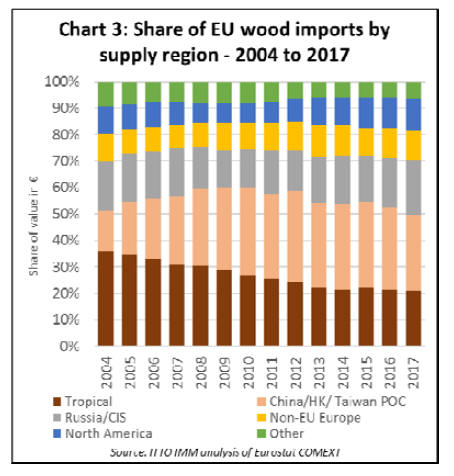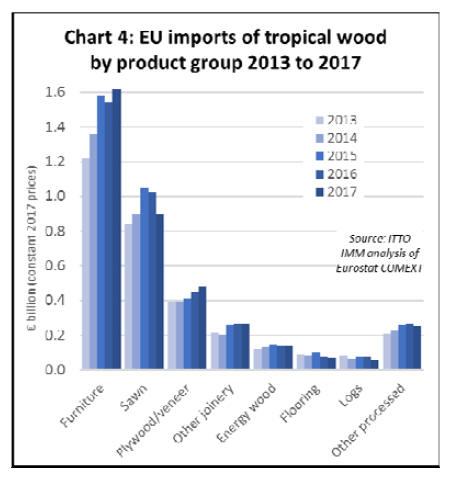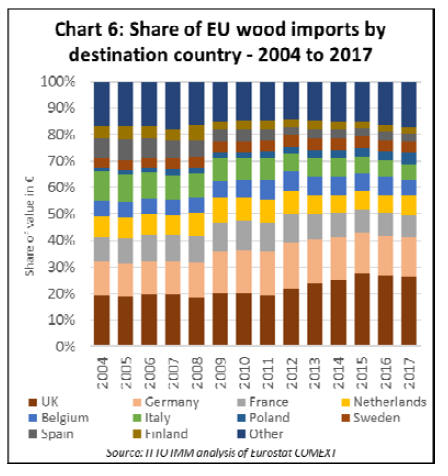|
Report from
Europe
Recovery in EU wood imports continues in 2017
The total value of EU imports of wood products was Euro
18.17 billion in 2017, 2.4% more than in 2016. This
followed an increase of 1.3% to Euro 17.74 billion in
2016. In 2017 EU import value was at the highest level
since 2008 just before the global financial crises (Chart 1).

Imports into the EU were boosted in 2017 by stronger
economic growth. According to Eurostat, the EU economy
grew at its fastest rate in 10 years in 2017, registering a
2.5% increase on the year before. That is the highest
annual growth since 2007, when the economy expanded
by 2.7%.
The bloc of 28 countries put in a strong performance in the
final quarter of the year, growing 0.6%, mainly driven by
good economic results from Germany, Spain and France.
Good economic growth fed through into a rise in the value
of the Euro last year, which strengthened against the U.S.
dollar by around 15% during 2017.
For importers in the eurozone, this helped offset the
general rise in global prices for timber products resulting
from strong demand in other regions including China,
North America and the Middle East.
Considering individual products (Chart 2), the value of EU
imports of wood furniture increased by 7.3% to Euro 6.29
billion in 2017 after a slight dip in 2016. EU imports of
wood furniture increased from all the main supply regions
last year, including China and South East Asia.
However, the strongest growth in EU furniture imports in
2017 was from European countries outside the EU. This
forms part of general trend of increasing EU dependence
on wood furniture manufactured in central and Eastern
Europe.

The value EU imports of sawnwood (including softwoods
and hardwoods) was unchanged in 2017, at Euro 3.2
billion, ending the rising trend which began in 2013. There
was a particularly significant 21% decline in the value of
EU sawn wood imports from Africa in 2017 which offset a
12% rise in imports from the CIS countries.
EU imports of sawn wood from Russia and other CIS
countries continue to benefit from the relative weakness of
currencies in the region.
EU imports of panels (mainly plywood) increased 9% to
Euro 2.79 billion in 2017. This follows a 3% rise in 2016
and an 11% increase in 2015. Most of this gain was due to
a rise in plywood imports from Russia and other Eastern
European countries. The value of EU plywood imports
from China and tropical countries was generally stable or
declining in 2017.
The long-term rise in EU imports of energy wood
continued in 2017 with annual import value exceeding
Euro 2.01 billion for the first time. This was only 3% more
than in 2016, a slower pace of increase compared to
average annual growth of 11% in the previous five years.
EU imports of energy wood (now dominated by pellets)
increased sharply from the CIS region last year. Imports
from the US, still by far the largest external supplier to the
EU, were stable in 2017.
Following a 22% increase in 2015 and 4% increase in
2016, EU imports of other joinery products (mainly doors
and laminated wood for window frames) declined 1% to
Euro 690 million in 2017.
Imports of joinery products from Russia and Ukraine
continued to rise last year, while imports from the tropics
and China lost ground (although China is still the single
largest external supplier).
EU imports of wood flooring were stable at Euro 550
million in 2017, after falling back 9% in 2016. Flooring
imports from China, by far the largest external supplier,
were flat in 2017, while imports from the CIS region
increased 12%, helping to offset a decline in imports from
South East Asia and South America.
The value of EU imports of wood products from tropical
countries decreased 1.8% to Euro 3.78 billion in 2017.
This follows a 1% fall the previous year. The share of
tropical countries in the total value of EU wood product
imports declined from 22% in 2016 to 21% in 2017. This
is a resumption of a long- term trend in declining share of
tropical countries in total EU imports after a brief rebound
in 2015 (Chart 3).

China¡¯s share in total EU imports of wood products fell
from 30.5% in 2015 to 28.9% last year, the lowest level
since 2008. Meanwhile the share of Russia and other CIS
countries increased from 19.3% to 21.1%.
In 2017, there was a slight increase in share of EU imports
from non-EU European countries (from 10.9% to 11%)
and North America (from 11.5% to 11.7%).
The slight decline in the total value of EU wood product
imports from the tropics in 2017 hides variations between
products groups (Chart 4).
Last year, there was a sharp 13% decline in EU imports of
sawn wood from tropical countries, from Euro 1026
million to Euro 896 million. There was also a continuing
decline in EU imports of tropical flooring, by 12% to Euro
68 million, and tropical logs, by 29% to Euro 53 million.
However, these declines were offset by rising EU imports
of tropical furniture, up 5% to Euro 1.62 billion, panels
(mainly plywood), up 7% to Euro 480 million, and energy
wood (notably charcoal), up 2% to Euro 143 million.

EU wood products exports at record level in 2017
In 2017, the EU exported wood products with a total value
of Euro 21.8 billion, 5% more than in 2016 and overtaking
the previous record level of Euro 20.51 billion in 2015
(Chart 5).
The EU increased exports of a wide range of wood
products last year, but there was particularly strong growth
in sawnwood, logs, energy wood, and panels. The
increased exports were mainly destined for North
America, China and other Asian countries.

Last year, the rate of EU export growth exceeded the rate
of import growth, resulting in an increase in the EU¡¯s
timber product trade surplus with the rest of the world,
from Euro 2.97 billion in 2016 to Euro 3.62 billion in
2017.
Brexit to significantly impact EU trade balance
Looking to the future, the EU trade data highlights the
extent to which Brexit will impact on the EU trade
balance.
The UK is consistently the largest EU importer of timber
products from outside the bloc, due partly to the country¡¯s
limited domestic forest resources, partly to the UK¡¯s
coastal position and traditional trade links with many
countries in other parts of the world, and partly to the
UK¡¯s relatively concentrated timber distribution and
retailing sectors which has been more accessible to
external suppliers, particularly in China and Asia.
The UK¡¯s share of total EU imports of timber products
from outside the bloc increased sharply from 19% in 2011
to 28% in 2015. The UK¡¯s share of total EU timber
product imports declined slightly in 2016 and 2017, but
only to a little under 27% (Chart 6).
During this time the UK was recovering from the financial
crises, driving a strong increase in imports from outside
the EU, particularly wood furniture and plywood from
China, and wood furniture from Vietnam.
There was also a big increase in UK imports of wood
pellets during this period, mainly from the U.S., driven by
the UK¡¯s climate change commitments which encouraged
some large energy suppliers to switch from coal to
biomass.

Without the UK, in terms of global trade, the EU becomes
more relevant as an exporter, and less relevant as an
importer of timber products. This is because the UK is not
only a large importer of timber products from outside the
EU, but also a large importer from other EU countries, and
only a small exporter to all parts of the world.
In 2017, the value of the timber trade surplus of the EU
excluding the UK was Euro 12.69 billion, more than three
times the Euro 3.62 billion surplus with the UK included.
Last year the EU27 (i.e. excluding the UK) imported Euro
13.91 billion (compared to Euro 18.17 billion for the
EU28) and exported Euro 26.60 billion (compared to
21.79 Euro for the EU28).
UK pledges to retain FLEGT commitment after Brexit
In relation to policy initiatives like FLEGT, the decline in
the relative significance of the EU as an importer of timber
products after Brexit will be mitigated by the commitment
of the UK government and timber trade to continue to
support the VPA process and EUTR.
Speaking at a meeting organized by the UK Confederation
of Timber Industries in February, Therese Coffey,
parliamentary under-secretary of state at the Department
for Environment, Food and Rural Affairs (DEFRA), stated
that: ¡°When the UK leaves the EU, the Withdrawal Bill
will make sure the whole body of European environmental
law continues to have effect in UK law.
That [includes] two regulations that the UK timber sector
played a great role in shaping: the European Union Timber
Regulation and the Forest Law Environment Governance
and Trade Regulation¡±.
She went on to state that: ¡°We are committed to
supporting sustainable and legal timber and forest
industries and recognize the value of the EUTR and the
EU FLEGT initiative in assuring this."
This was believed to be the first time that a UK minister
had made a definitive statement of this kind and was
welcomed by the audience of forestry and timber sector
representatives and leading businesses.
¡°The UK timber sector was at the forefront in the
development of the EUTR and the EU FLEGT initiative
and the vast majority of our members support their
retention post-Brexit,¡± said David Hopkins, UK TTF
Managing Director, and Director of the CTI.
¡°The EUTR is a business friendly, flexible regulation to
ensure goods are sourced responsibly, protecting the
environment and business reputation. Abandoning the
regulation [and support for the EU FLEGT initiative] now
would cause unnecessary upheaval and market confusion.
I would like to thank the Minister for this commitment and
giving us the certainty our sector needs.¡±
|